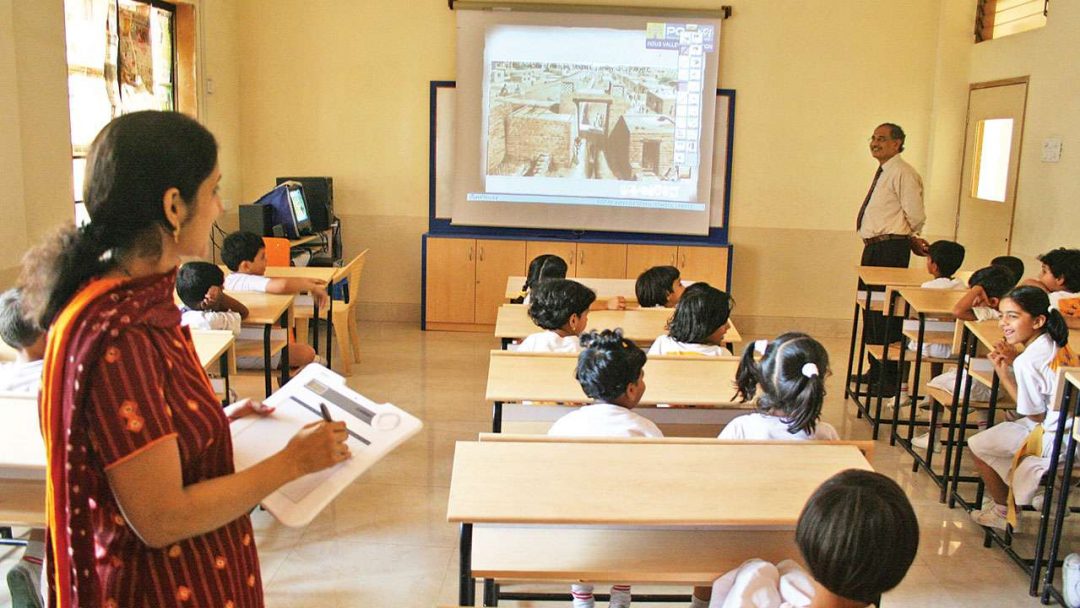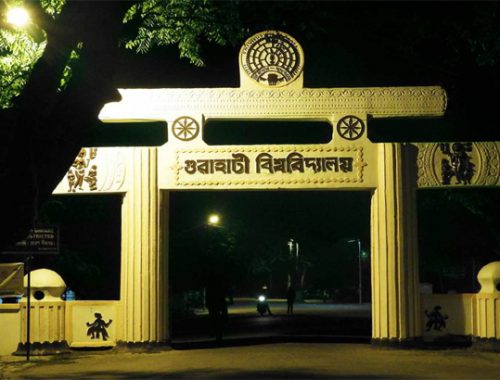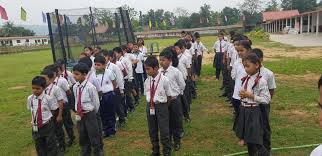AAP government brought a visible change in Delhi’s public education system, which is being adopted by other states as well. But the exam is not over yet.
The Aam Aadmi Party won a massive landslide in 2015 Delhi assembly election. One of the key promises of the AAP in the 2015 polls was to transform the government schooling system in the national capital territory. A quick glance at the outcomes suggests the insurgent party has not disappointed on this key promise.
With slogan such as ‘education first’, the AAP-led government appears to have infused fresh bouts of energy into a moribund education system, especially the government run schools in Delhi. The AAP government under the leadership of Arvind Kejriwal and his deputy Manish Sisodia, who holds the education portfolio, has allotted highest funds to education, introduced new teacher training courses for students, and have infused money to improve ailing schooling infrastructure.
Overall outcomes of these efforts are visible. For instance, a Delhi government school Rajkiya Pratibha Vikas Vidyalaya (RPVV) in Dwarka was ranked number one among all government-run day schools in India, while two others have made it to the top ten in 2019. Here is a quick overview of series of reforms and initiatives taken by the AAP government to improve Delhi’s education system in the last five years.

Delhi Education Minister Manish Sisodia and Chief Minister Arvind Kejriwal addressing the media | Photo: Manisha Mondal | ThePrint
More funds for education
The AAP government has made education and revamping of government schools a priority as part of its governance framework. From 2015 onwards, the AAP government has allocated a major amount of budget for introducing remarkable education sector amendments. In 2015-16, it allotted Rs 6,208 crore for the school and higher education sector. In the 2016-17 annual budget, the state government further increased education sector spending to Rs 8,642 crore (budgeted). In 2017-18, the Kejriwal government spent as much as Rs 9,888 crore and in 2018-19, it went up to Rs 11,201 crore (revised). In 2019-20, the budgetary allocation was a significant Rs 15,133 crore (budgeted).
The increased budget in education sector has largely been devoted to address core areas such as the strengthening of ailing school infrastructure, revamping teacher-training system and students learning programmes. It may be noted that when the AAP government came to power in 2015, the conditions of most government schools in Delhi were in a sorry state, with more and more parents particularly from economically poorer backgrounds sending their wards to private schools with considerable financial burdens.
This is where the AAP pitched its support to bring a turnaround quickly. Atishi Marlena, a Rhodes scholar who worked as adviser to Manish Sisodia, deputy chief minister of Delhi played a decisive role in transforming school education system in Delhi. The government took many significant decisions in quick succession. For instance, apart from devoting more money, the Directorate of Education constructed 21 new school buildings with modern facilities and 8,000 equivalent new classrooms have been added at the same time.
The government schools were provided required financial assistance to have labs with modern facilities, SMART classrooms and e-modules to make learning attractive. Notably, to make classroom experience stimulating for students, the government introduced happiness curriculum with array of innovative classroom learning tools. Furthermore, the AAP government took the crucial initiative of creating a three–tier library structure in the schools. In addition, all government schools have now functional drinking water and girls and boys toilets, electricity connection and 88.82% schools had computer facilities.
Another significant intervention made by the AAP government was with regard to teachers’ training. Delhi government in 2017 started a one-of-a-kind teacher training exercise across the city. The State Council for Education Research & Training (SCERT) undertook an extensive capacity building exercise for more than 36,000 teachers — 26,000 Trained Graduate Teachers (TGTs) and 10,000 Post Graduate Teachers (PGTs), who were teaching in schools run by the Delhi government. Keeping in mind the latest innovation in classroom learning, the concept of group-based learning has been introduced in teacher training so that the technique percolates to classrooms of Delhi government schools as well.
To further improve the quality of education in Delhi government schools and to enhance teacher’s instructive capabilities, the AAP government initiated a Teacher’s Training Programme. The motive behind the programme was to keep the teachers abreast with the contemporary knowledge of their subject. In 2018, 200 teachers received training by world’s top educators- National Institute of Education (NIE). These 200 teachers, after the completion of the course, were regarded as ‘mentor teachers.’ The trained teachers were assigned around five to six schools, which they visit regularly to observe classroom practices and provide on-site learning support to other teachers.
Among other critical steps to revamp public education, the government also took a series of small but beneficial steps to improve students’ learning outcomes. With surveys indicating a record number of students unable to read and comprehend basic concepts at various classes and age groups, the government launched an ambitious project named ‘Chunauti’ in 2016 with the aim of seeking to check student dropout rates and improve the quality of education with special focus on the weakest students.
The aim was to have all students in upper primary classes be able to read, write and do basic mathematics. It has been reported that Chunauti has brought visible improvement in the pass percentage of class IX. Similarly, class XI results made impressive improvement in pass percentage. While the pass percentage was 71% in 2017-2018, it reached 80% in 2018-19. According to a Praja Foundation report, class 12 results have has also shown consistent improvement since the Aam Aadmi Party came to power in 2015. Overall, the AAP government’s stepped up efforts has brought school education onto the center stage.
Major challenges
While the government has brought visible improvement in many spheres related to state run schools, the battle is only half won. While the AAP government has done well to change the perception of government-run schools by infusing more funds and plucking low hanging fruits, many long-standing problems remain to be addressed. For instance, despite all the efforts, the enrollment rate in Delhi state school has fallen. According to the Praja Foundation report, ‘State of Public (School) Education in Delhi’, published in March 2019, enrolment rate in Delhi government schools has fallen by 8% from 2013-14 to 2017-18. In government schools, the enrolment rate for Class I saw a dip of 4.8% in 2017-18.
Another survey by Praja Foundation shows that 2,59,705 students who got enrolled for class IX in Delhi government schools in 2014-15, 56% did not reach class XII in 2017-18. This shows very poor retention in state-run schools. Data available on the state government site ‘edudel’ indicates that a mammoth 55% of students did not go to the Class X in the academic year 2017-18 from Class IX (academic year 2016-17). This means a large number of students failed in Class IX.
Despite all the efforts, the enrolment rate in Delhi state school has fallen.
Similarly, despite many efforts, Delhi government schools have failed to improve critical Xth board results. Only 68.95% of students were able to pass the X class boards in the academic session 2017-18, whereas the pass percentage for central government-run schools was 97.03% in the same academic year. Praja Foundation report further states that Continuous and Comprehensive Evaluation (CCE) results in state government schools shows that maximum per cent of students in standards VIth, VIIth and VIIIth fall in and below Grade C – 78%, 80%, and 78%, respectively. This is a reflection of poor learning outcomes as reflected in the high percentage of students failing in class IX.
Similarly, another report suggests that Delhi Government schools are operating with only 57% regular teachers while the rest of the responsibility is with guest teachers. A huge gap persists in the sanctioned and filled positions, both among the teaching and non-teaching staff in Delhi government schools. According to information made available to the public through RTI applications, it can be said that out of 1,029 schools only 301 schools across Delhi have science as a subject.
Notwithstanding these limitations, the AAP government in its first full tenure brought a visible transformation in the public education system in the national capital. The education system of Delhi is being adopted by other states as well. The government managed to bring major changes in the education system and was able to overcome the major challenges they faced. However, the major challenges still remain to be addressed. While the government revamped the infrastructure, but failed to recruit permanent teachers. It introduced new programmes, but the enrollment rate witnessed a fall. In short, the AAP’s claim of ‘revolutionising’ school education remains a work in progress.
by Niranjan Sahoo, PhD. He is a Senior Fellow with ORF’s Governance and Politics Initiative. Views are personal.




